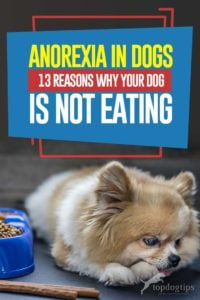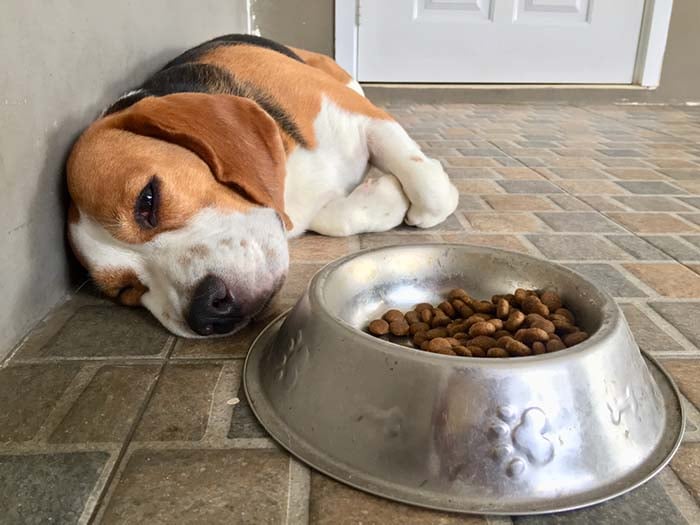Table of Contents
Few things are as alarming to pet owners as when our dogs stop eating.
Okay, there’s the mysterious lumps and bumps, the vomiting of unknown origin, the possible ingested foreign object… but anorexia in dogs and our dogs refusing to eat definitely ranks up there as one of the more panic-worthy moments.
So, if you think, “Why is my dog not eating?” here are some reasons this might be happening.
Firstly, it’s important to note that there are countless reasons why your dog may have stopped eating.
It could be anything from boredom with their food selection (or angling for more of those tasty table scraps you’ve been feeding on the sly) to something more sinister.
The only way to determine the cause of your dog's anorexia is to head to your vet.
Types of Anorexia in Dogs
When we talk about “anorexia” in a veterinary context, we are simply talking about a loss of appetite.
Dogs may also exhibit partial anorexia, which means that they are eating, but they aren’t eating enough to get the proper nutrition their body requires.
Lastly, dogs may also exhibit something called “pseudo-anorexia.”
A dog with pseudo-anorexia has the desire and appetite to eat, but they are unable to eat due to a primary cause, such as rotten teeth or being in pain.
So, what could be the reasons for anorexia in dogs?
The main reasons for anorexia in dogs and dogs not eating can be behavioral, or they can be physical. Let's take a closer look at both of these.
WATCH THIS: How to Get a Dog with No Appetite to Eat
Behavioral Reasons Why Your Dog Isn’t Eating
1. Being Picky
We like to spoil our dogs, but when we spoil them with too many tasty treats, table scraps, human food, etc., you can hardly blame them for turning their nose up at a bowl of dried kibble.
Given the choice of eating the same dry kibble for every meal for the rest of your life or eating various delicious human foods, which would you choose?
Our dogs are certainly not born this way, but unless you maintain a proper healthy diet, they can easily come to behave like this and develop anorexia.
Do your dog a favor: stick with a nutritionally appropriate canine diet and limit treats to one or two a day, or you risk creating a “monster.”
2. Stress
Like us, our dogs can experience stress.
The reasons for their stress can be the same as our own, or they can be specific to the “canine world”, but whatever they are, they can influence your dog’s appetite.
Our dogs live in a foreign world – our world – where they depend on a steady routine to know what to expect and how to respond.
As pet parents, we give our dogs a blueprint of this structure through training and repetitive behavior.
When something occurs that doesn’t fit that blueprint, it causes great anxiety and stress for our dogs.
While they are preoccupied with what’s happening and why things have changed, they are much less likely to be focused on food, and you're more likely to spot signs of stress in them.
3. Poor Quality Food Options
Your family's budget can be the cause of anorexia in dogs.
For example, if you have been feeding your dog a premium brand dog food for most of their life and suddenly financial constraints forced you to cut back and feed your pooch lesser quality food, they may react to this change poorly.
Imagine if you had been eating prime rib all of your life and one day you were given beef shank instead – you’d notice the difference, wouldn’t you?
Some dogs do, too.
Of course, there are dogs like our beloved chowhound Labrador who eat anything and everything going, but don’t be surprised if your canine fits into the former category with drastic dietary changes.
4. Depression and Anxiety
Like us, our dogs are susceptible to concerns like depression and anxiety.
Each of these concerns can contribute to dog anorexia in the same way that they do for us.
For example, a dog that is depressed after losing his littermate, whom he has lived with for twelve years, is likely to show signs of depression, which can lead to anorexia.
Also, a dog that suffers from severe anxiety is going to be so preoccupied with that anxiety that they may refuse to eat.
We had a dog who suffered terribly from anxiety, so much so that when veterinary technicians offered him the most delicious of puppy treats, he would take it, let it fall out of his mouth, and then hide.
His priority was to get to a safe place and serve that fight or flight mechanism rather than eat.
5. Something Better is Around (i.e. Manipulation)
If you’re in the habit of feeding your dog human food and you put your dog’s food down at the same time that you are eating with your family, you may be in for the “stink eye.”
Dogs that have been spoiled by human food are more likely to protest their kibble when human food is a viable alternative, and that protest manifests itself through anorexia in dogs.
ALSO READ: 9 Emergency Dog Health Conditions That Cannot Be Delayed
Physical Reasons for Anorexia in Dogs
6. Pain
Pain is a great equalizer across every race of living thing – when we are in pain, we avoid food.
Even when pain isn’t directly related to the process of eating, we avoid food because the symptoms associated with pain are too overwhelming.
Imagine you have the worst migraine of your life. The last thing you want to do is to eat a meal.
Not because eating would worsen your migraine per se, but because:
- We can think of nothing else but that constant pain.
- Severe pain often causes nausea.
- The body often “turns off” the chemicals that signal appetite when we are in pain.
7. Poor Dental Health
If you’ve ever had a toothache, you know the pain it brings.
Like us, our dogs can experience toothache, and like us, that toothache can impact their appetite.
Some of the dental causes of anorexia in dogs include cracked or chipped teeth, cavities, abscesses, broken teeth, oral infection, or completely rotten teeth.
If your dog is not eating due to dental pain, they must have that pain remedied with veterinary dental care as soon as possible so that they can go back to a normal life.
Your veterinarian may suggest an alternative diet option while you await any surgical or dental procedures to ensure they get the proper nutrition required.
8. Recent Medical Procedures or Medication Additions
Recent medical procedures may also be a cause for loss of appetite and anorexia in dogs.
Part of this is likely to result from pain, but it may also link to adding medications to your dog’s daily routine.
Pet medications can suppress appetite because anorexia is a side effect of that medication, or they can cause a dog to eat less simply because they feel woozy, are sleeping most of the time, or just feel less like themselves.
Unfortunately, we can’t explain to our dogs that these feelings are transitory and that they should eat, but in many instances, a little coaxing with something like Doggy Bone Broth or sprinkling dog food toppers/mixers on top of their meals can help.
9. Overindulging on Snacks and Treats
Another reason why your dog may refuse to eat is that they’re too full after gorging on snacks and treats.
This could be the result of a Houdini dog that finds their way into the food pantry, or it could be the result of a sneaky family member.
Whatever the cause, if your puppy's belly is too full of goodies, they won’t give that bowl of kibble a second thought.
10. Illness
Illness can range from a cold to cancer, and in both examples, a side effect can be the loss of appetite.
While our bodies are hosting an attack on “foreign invaders,” most of us feel so drained that all we want to do is sleep.
Our focus is certainly not on eating our next meal because every resource our body has is directed at killing off the cause of our illness. Were we to eat, precious bodily resources would have to be redirected to digestion.
Our dogs function in the same way. The canine body’s instinct is to shut down any “superfluous” processes so that the focus is on eliminating “abnormal” cells or organisms that are causing us to feel unwell.
11. An Obstruction
Some dogs are determined to dig out, sniff out, or hunt down something that they are not supposed to have.
There are the dogs that eat rocks, the dogs that eat socks, and the dogs that eat… anything they can get their paws on.
Depending on what type of foreign body and the size of the foreign body your dog has eaten, they are going to begin suffering the symptoms of obstruction, one of which will be anorexia in dogs.
An obstruction is just what it sounds like – a foreign body blocking the dog's intestine and preventing food from passing through the intestinal tract.
If your pooch does experience an obstruction, it’s crucial to address the problem immediately.
Left untreated, your dog will lose their appetite, experience weakness, and weight loss, and may experience necrosis of intestinal tissue.
12. Gastrointestinal Problems
Gastrointestinal and digestive problems don’t have to be as serious as an obstruction to affect your dog’s appetite.
Something as “simple” as a stomachache can cause anorexia in dogs as well.
Many causes of gastrointestinal discomfort can lead to dogs refusing to eat, and some of these include:
- Food poisoning
- Gastroenteritis
- Colitis
- Pancreatitis
- Food sensitivities, intolerances, or allergies
13. Parasite Infection
Last on our list (although there are many more causes of anorexia in dogs to consider and discuss with your vet) is a parasitic infection.
While some parasites like tapeworms can cause your dog to eat more food, some parasites like Giardia have the opposite effect.
Keeping your dog up to date on their preventative medications can help to prevent these parasites and tickborne illnesses from taking hold, but an annual vet visit is also recommended to check for any parasites that may have “slipped through the cracks.”
How Long Should You “Watch and Wait” When Your Dog Has Stopped Eating?
There are dog parents who don’t panic at the slightest thing and give symptoms a reasonable amount of time to resolve before heading to the vet.
There are also dog parents who are under temporary financial strains and can’t afford an unnecessary visit to the vet.
We are NOT veterinarians; thus, the recommendations above and below are based on our collective experiences and should NOT be taken as hard and fast veterinary advice.
We recommend visiting your vet right away if…
- Your gut tells you something is wrong, and you must go to the vet – it’s better to be safe than sorry.
- Your dog is a puppy, an elderly dog, is very small, has a compromised immune system, or is sick or frail; go to the vet now. These dogs are considered part of an “at risk” population, which means that they could very quickly succumb to illness, and sometimes, as little as an hour delay in seeking vet care makes a difference.
- Your dog is exhibiting any other symptoms that give you cause for worry – trouble breathing, blood in their stools or vomit, a bloated abdomen, pain, etc.
- Your dog shows signs of general discomfort like pacing, being unable to get comfortable, laying down only to get up, pace, and try to lay down again… These are all signs that your dog could suffer from serious GI issues that require veterinary intervention immediately.
- Your adult dog has missed more than two meals, you should check in with your vet via phone to explain your dog’s symptoms at the very least.
- Your dog has vomited multiple times, vomits as soon as they try to eat, or has blood in their vomit.
- Your dog shows signs of lethargy, weakness, low blood sugar, or anemia.
 Dealing with anorexia in dogs can sometimes be fast and simple, or it can be a long and complicated process, depending on the reasons why your dog is refusing to eat.
Dealing with anorexia in dogs can sometimes be fast and simple, or it can be a long and complicated process, depending on the reasons why your dog is refusing to eat.
You know your pup, and you know when they’re feeling unwell or out of the ordinary.
Often, this knowledge allows us to judge when our dogs need veterinary intervention.
If you are unsure, please call your vet immediately rather than turn to an internet forum for advice.
Your vet knows your dog’s health history and is professionally trained to identify symptoms, and they can start treatment immediately if necessary.















